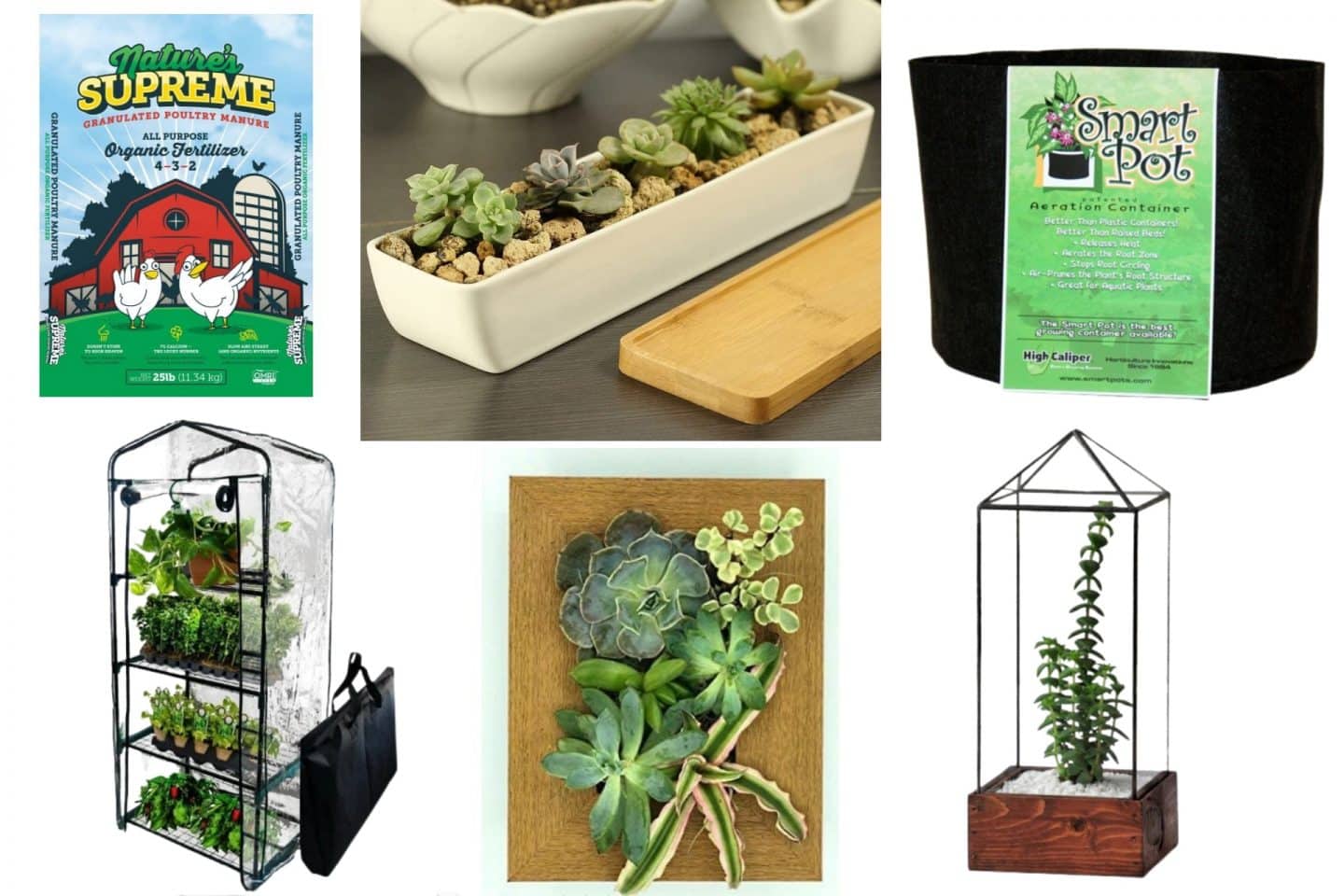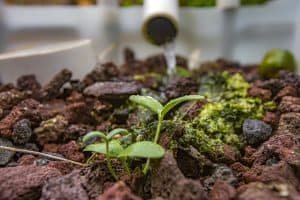Are you one of those people with a green thumb, but no yard to put your skills to use? Or maybe you just don’t have the time or energy to care for a garden. Don’t worry, you can still enjoy homegrown produce by growing plants indoors! Here are some ideas for creating an indoor garden that will fit in even the smallest spaces.
Are you short on space but still want to garden? You’re in luck. There are plenty of indoor garden ideas for small spaces. You can grow vegetables, fruits, and herbs indoors using simple techniques and containers. Whether you have a sunny window or just a little bit of floor space, there’s a container garden solution for you. Keep reading for tips on how to get started.

Benefits of Indoor Gardening
There are plenty of reasons to start an indoor garden, even if you have a yard and outdoor space to grow plants. Here are some benefits of indoor gardening:
Readily Available Fresh Produce
One of the best things about having an indoor garden is that you can have fresh herbs, vegetables, and other produce at your fingertips. Growing your own produce indoors means that you can have access to fresher and healthier food.

Controlled Environment
One benefit is that you can control the environment indoors much better than outdoors. This means you can extend the growing season and grow plants that might not do well in your climate. For example, if you live in a cold climate, you can grow tropical plants indoors.
Pest and Disease Control
It’s easier to control pests and diseases when you’re gardening indoors. You can keep an eye on your plants more easily and take action quickly if you see any problems. Additionally, growing plants indoors can help keep pests and diseases out of your outdoor garden.
No Weeding
Weeds are less likely to be a problem when you’re gardening indoors. This frees up your time so you can focus on other aspects of plant care, such as watering and fertilizing.
Space Saving
Another great benefit of indoor gardening is that it doesn’t take up much space. If you have a small apartment or home, you can still grow a variety of plants indoors. All you need is a sunny windowsill or a few square feet of floor space.
Fresher Air In Your Home
Everyone knows plants feed on carbon dioxide and release oxygen. But did you know that indoor plants can actually help purify the air in your home? They can remove harmful toxins and chemicals, resulting in fresher, cleaner air for you to breathe.
Adds Color to Your Home
In addition to purifying the air, indoor plants can also add a touch of green and color to your home. They can brighten up a room and make it feel more inviting.
Stress Relief
One reason many people get into gardening is to relieve some of the stress in their lives. Caring for plants can be therapeutic and help you relax. It can be a great way to unwind after a long day or take your mind off of things that are bothering you.
Improves Cognitive Health
Studies have shown that being around plants can actually improve your cognitive health. One reason for this is that plants help reduce stress and anxiety. They can also improve your mood, help you think more clearly and make better decisions, and increase your productivity. This is why many workplaces have plants in their offices. This is also why you need an indoor garden especially if you work from home.

What You Need To Start An Indoor Garden
You don’t need a lot of fancy equipment or supplies to start an indoor garden. All you really need is a container, some potting soil, plants, gardening tools, a watering can or a plant mister, and other gardening tools like a pruner and a trowel. Oh, and you need a space in your home for your indoor garden. Ideally, a place that gets enough sunlight for your indoor plants to thrive.

Most of the indoor garden needs are pretty basic. There are lots of indoor garden plants you can choose from. It’s a good idea to have a variety of plants in your garden. As for the containers, you also have plenty of options. Here are some ideas for containers you can use:
Pots and Planters
Pots and planters are one of the most popular options for indoor gardens, as they can be placed almost anywhere in your home. If you have a sunny spot in your kitchen, for example, you could place a small herb garden on your windowsill. Or, if you have a bit more space to work with, you could fill a corner of your living room with large potted plants.
Window Boxes
Window boxes are another great option for small spaces, as they can be hung on any window with a sill. This is a great way to add greenery to a room without taking up valuable floor space.
Grow Bags
Grow bags are an increasingly popular option for indoor gardens, as they are lightweight and easy to move around. They also offer excellent drainage, which is important for preventing root rot.
Hanging Baskets
Hanging baskets are another great way to add greenery to small spaces, as they can be hung from the ceiling or on wall hooks. Hanging baskets also offer the benefit of freeing up valuable floor space.
Recycled Materials
There are endless possibilities when it comes to recycled materials that can be used as containers for indoor gardens. Old coffee cans, mason jars, plastic bottles, and even empty egg cartons can be repurposed into planters. Just make sure to punch some drainage holes into the bottom of the container before adding soil and plants.
Creative Indoor Garden Ideas When Space Is Limited
If you love spending time outdoors surrounded by beautiful plants and flowers, but don’t have the luxury of a large yard, indoor gardening may be the perfect solution. Indoor gardens are becoming increasingly popular, as they allow even city dwellers to enjoy the benefits of fresh air and greenery.
Whether you have a small balcony, a sunroom, or simply an empty corner in your home, there are plenty of indoor garden ideas to suit your space. Below are some of our favorite indoor garden ideas for small spaces.
Water Propagation Method
This indoor garden idea is best for growing plants that have stems or leaves that can be rooted in water, such as Begonia, Hoya, Philodendron, Pothos, and Snake Plant. Vegetables like garlic, leeks, onions, sweet potatoes, and lemongrass can also be propagated using this method. Herbs that you can propagate in water include basil, mint, oregano, rosemary, sage, mint, lemon balm, stevia, and thyme.
To propagate using the water method, fill a clean glass or jar with fresh water. Use a garden scissor or pruner to cut the leaves or stems. Make sure the cut is made below a leaf node, which is where new roots will grow from. Place the cutting in the water so that the leaves or stems are submerged. Place the container in a sunny spot and change the water every few days to keep it fresh.

Roots should start to form within a few weeks. Once they’ve grown to be a few inches long, you can plant them in soil either in your garden outside or in containers indoors. Remember to keep the soil moist for the first few weeks as your plant will be used to sitting in water at that point.
Living Wall
Have you heard of paintings or photos being called a “living work of art?” Well, a living wall is just that – a wall made of living plants! If you’re tight on space but still want to have an indoor garden, this is a great solution. You can create a living wall using either soil-based or hydroponic methods.

To create a living wall using the soil-based method, you’ll need a frame (you can use anything from an old picture frame to chicken wire to a metal grid), potting mix, plants, and water. Start by attaching your frame to the wall. Then fill it with potting mix and plant your chosen plants. Be sure to leave enough space between each plant so that they have room to grow. Water regularly and fertilize as needed.
The hydroponic method is a bit different. Instead of using soil, the plants are grown in water that’s been enriched with nutrients. You’ll need a frame, a nutrient solution, plants, and water. Start by attaching your frame to the wall and then adding your nutrient solution. Plant your chosen plants and then add water. The water should be changed regularly and the nutrient solution should be replaced every few weeks.
Hanging Gardens
Hanging gardens are a great way to save space and add some green to your home. They’re also relatively easy to create. All you need is a container, potting mix, plants, and something to hang your garden from (a hook, a nail, etc.). Start by filling your container with potting mix and then planting your chosen plants. Once the plants are in place, water them well. Then hang your container from the chosen spot and water as needed.
Terrariums
Terrariums are like mini gardens that you can create using a variety of different containers. They’re perfect for small spaces and require very little maintenance. To create a terrarium, start by choosing a container. Then add a layer of gravel or sand to the bottom for drainage. Next, add a layer of charcoal (this helps to keep the terrarium clean). Add a layer of potting mix and then plant your chosen plants. Be sure to leave enough space between each plant so that they have room to grow. Once the plants are in place, add a layer of moss or lichen. Finally, add a layer of stones or shells for decoration. Water as needed and keep the terrarium in a spot with indirect light.
Vertical Gardening
If you don’t have a lot of floor space, why not grow your plants up instead of out? This is called vertical gardening and it’s a great way to make the most of a small space. There are a few different ways to do this. One is to use a trellis. You can either buy one or make your own using chicken wire or lattice. Another option is to use a hanging planter. These come in all sorts of shapes and sizes and can be hung from the ceiling, a wall, or even a window. Whichever method you choose, be sure to water regularly and fertilize as needed.
Window Sill Gardens
Window sill gardens are one of the easiest indoor garden ideas for small spaces to get started with. All you need is a windowsill, potting mix, plants, and water. Start by choosing a spot for your garden. Then add enough potting mix to fill the container. Plant your chosen plants and water as needed. Some popular plants for window sill gardens include cacti, succulents, and even Venus fly traps. Be sure to keep an eye on the light levels and adjust accordingly. If you live in a colder climate, you may need to take your plants away from the window during the winter months.
Trailing Vines
Trailing vines are a great way to add some greenery to your home without taking up a lot of space. They also help to purify the air and can even help to reduce noise levels. To grow trailing vines, simply grow them in containers that you can hang from the ceiling, wall, or curtain rails. Just make sure you can reach them when you have to water the vines or want to take them out a bit for some sun. Choose low-maintenance trailing vines such as Devil’s ivy, spider plants, or philodendrons. Water regularly and fertilize as needed.
Tabletop Gardens
A tabletop garden is a small garden that can fit on a table or other surface. They’re perfect for small spaces and require very little maintenance. To create a tabletop garden, start by choosing decorative containers. The prettier the pots are, the more your indoor garden will stand out. Next, add a layer of gravel or sand to the bottom for drainage. Then add a layer of potting mix and plant your chosen plants. Those that require low to medium light, like pothos and lucky bamboo, are ideal for an area in your home that doesn’t get that much sun. Aloe vera and ponytail palm also look great in tabletop gardens. Water as needed and keep your garden in a spot with indirect light.
Fairy Gardens
Fairy gardens are small gardens that are designed to look like they’re inhabited by fairies. They can be created using a variety of different containers, such as bird baths, old wheelbarrows, or even tree stumps. To make a fairy garden, start by adding a layer of gravel or sand to the bottom of your container for drainage. Then add a layer of potting mix and plant your chosen plants. Once the plants are in place, add some small figurines or other decorations to create the look of a fairy garden. Water as needed and keep in a spot with indirect light.
Bathroom Garden
The bathroom is often one of the darkest rooms in the house, which makes it a great place to grow plants that don’t need a lot of light. There are a few different ways to do this. One is to hang plants from the ceiling or shelves. Another option is to use mason jars or other clear containers. Fill them with potting mix and plant your chosen plants. If you have a bathroom with a window, you can also use that as a spot for your garden. Just be sure to choose plants that don’t need a lot of light. Some great bathroom garden plants include orchids, snake plants, Begonia, Bromeliad, and ZZ plants.

While a small garden may take some extra effort, the benefits are worth it. Not only will you have access to fresh produce all year round, but you’ll also enjoy the satisfaction of watching your plants grow and thrive.
If you’re short on space, don’t worry – there are plenty of indoor garden ideas for small spaces that will let you grow your own herbs, vegetables, flowers, and decorative plants even in the tightest quarters. Whether you have a sunny spot in your kitchen or a little corner of the living room to spare, there’s an option out there for you. All you need is a little bit of creativity and some basic supplies and you’re well on your way to having fresher and healthier food at your fingertips. Not to mention, it’ll taste a whole lot better than what you’d find at the grocery store!
So get ready to roll up your sleeves and start planting – your green thumb is waiting! Do any of our indoor garden ideas appeal to you? If so, be sure to check out Gentleman Pirate Club for more gardening and homesteading tips. And feel free to share any indoor gardening tips you might want to add.
Just a disclaimer – We have partnered with these companies because we use their products and/or proudly trust and endorse them – so we do receive a commission if you make a purchase or sign up for services. Often, we are able to negotiate special discounts and/or bonuses, which we will pass on to you via our links. We often get short notice on sale items available for 24-48 hours as we will pass these savings on to you.
























